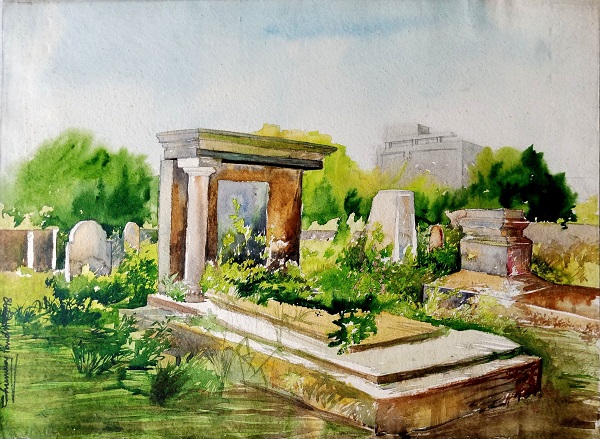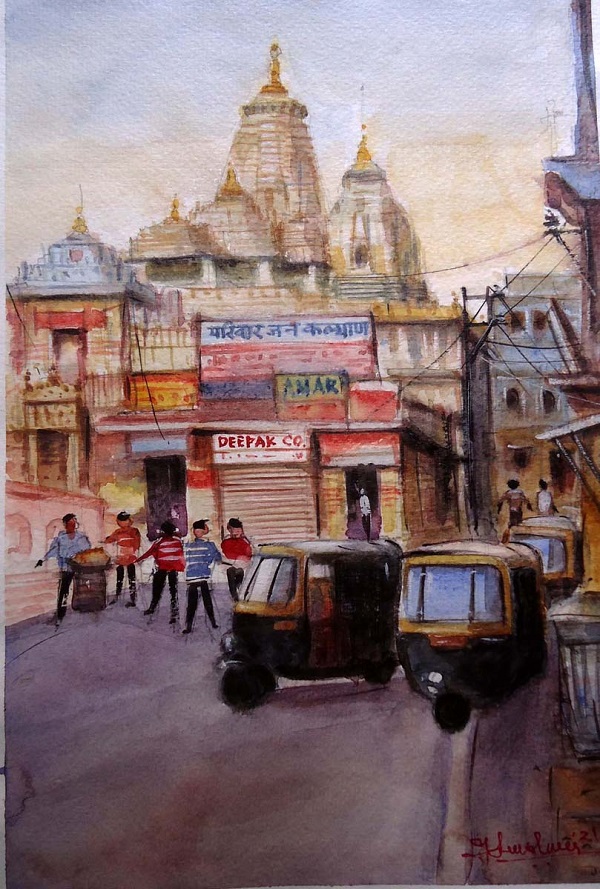
Watercolor paintings, with their soft, dreamlike qualities, have captivated audiences for centuries. Yet, these seemingly simple works hold a hidden power: the ability to redefine artistic boundaries. Unlike other mediums, watercolors dance between control and chance. Each brushstroke is a conversation with the water, yielding unpredictable results that challenge the artist's vision. This very unpredictability forms the core of their magic. Watercolors force artists to embrace the unexpected, redefine their understanding of precision, and ultimately, redefine art itself.
Throughout history, watercolors have consistently challenged established norms. Once relegated to mere sketches, artists like Turner and Dürer pushed their potential, capturing light and atmosphere with unprecedented subtlety. Romantics like Friedrich further redefined artistic expression by using watercolors to convey the awe-inspiring power of nature, contrasting sharply with the dominant, unemotional styles of the time.
Today, watercolors continue to be a vibrant and evolving medium, pushing boundaries and challenging definitions. They offer a refreshing reminder of the beauty of imperfection and the transformative power of embracing the unexpected. By exploring them further, we can unlock a deeper appreciation for their magic and their enduring legacy in the ever-evolving world of art.
The Beauty of Watercolor Paintings
Watercolor paintings are like the daydreamers of the art world. Soft, dreamy colors blend together in a way that feels almost magical. Unlike oil paintings where you can paint over mistakes, watercolors are all about embracing happy accidents. Each brushstroke is a conversation with the water, creating an unpredictable masterpiece. They can capture anything, from peaceful landscapes to bustling cityscapes, all with a touch of whimsy and a whole lot of personality. Watercolors showcase a perfect blend of different hues, gaining the attention of viewers in a matter of seconds.

The Role of Watercolor Paintings in Redefining Art
A Dance of Control and Chance
Unlike many other mediums, watercolor paintings require a delicate harmony between control and chance. Each brushstroke is a conversation with the water, yielding unpredictable results that can surprise both the artist and the viewer. This very unpredictability is part of the magic. Watercolors force artists to embrace the unexpected, redefine their understanding of precision, and ultimately, redefine art itself.
A Palette of Emotion
Beyond mere aesthetics, watercolors offer a powerful tool to convey a range of emotions. The transparency of the medium allows for subtle variations in color and light, capturing not just the physical world but also the artist's emotional response to it. From the gentle hues of a peaceful landscape to the vibrant colors of a joyous celebration, watercolors possess the unique ability to evoke a spectrum of emotions within the viewer, creating a connection that transcends the physical boundaries of the artwork.
The Poetry of Imperfection
Unlike the controlled precision attainable with other mediums, watercolors embrace the element of surprise inherent in the interaction between paint and water. Each brushstroke carries a sense of adventure, as the artist relinquishes complete control to the flow of water. This dance between intention and chance fosters a unique elegance, celebrating the beauty of imperfection and imbuing the paintings with a sense of spontaneity and dynamism.

Read More: Watercolor Paintings Vs Oil Paintings
Characteristics of Watercolor Paintings
Watercolor paintings are renowned for their unique characteristics, which contribute to their ethereal beauty and artistic charm. These characteristics set them apart from other mediums and present both challenges and opportunities for artists. Here are some key aspects to consider:
Transparency and Opacity
Transparency: Transparency is one of the defining features of watercolor paintings that make them unique and captivating. The subtle paint and brush strokes allow light to pass through, reflecting back the white of the paper and creating a luminous effect. This characteristic is evident in the soft washes and subtle color gradations that are hallmark features of watercolor paintings.
Opacity: While transparency is dominant, some watercolors can be opaque, meaning they block light and appear more solid. This can be utilized to create bolder colors and add contrast to the painting. Additionally, the mixed use of transparent and opaque watercolors creates a unique look, adding to its beauty and elegance.
Water Control and Staining
Water control: Water plays a crucial role in watercolor painting, acting as both a carrier and a diluting agent for the colors. The artist needs to master controlling the flow and absorption of water to achieve the desired effects. Too much water can lead to uncontrolled washes, while too little can result in harsh transitions and difficulty blending colors. Thus, proper control of water is required in order to achieve the desired result.
Staining: Different pigments exhibit varying degrees of staining. Staining pigments penetrate the paper fibers, making them difficult to remove or lift once laid down. Non-staining pigments offer more flexibility for corrections and layering. Understanding staining properties is crucial for planning and executing a successful watercolor painting.
Granulation & Texture
Granulation: Some watercolor pigments have a grainy consistency, resulting in a speckled or textured effect when applied. This characteristic can add visual interest and depth to the painting, mimicking natural textures like sand or tree bark. Additionally, this grainy texture also provides a 3D effect to the watercolor painting, increasing its overall aesthetics.
Texture: While watercolors are primarily associated with smooth washes, artists can explore various techniques to introduce texture. This can be achieved by using textured paper, applying thick paint layers with impasto techniques, or utilizing mediums like salt or masking fluids.
Lightfastness and Permanence
Lightfastness: Watercolor pigments vary in their lightfastness, which refers to their resistance to fading over time when exposed to light. Choosing pigments with high lightfastness is crucial for ensuring the longevity of the artwork, especially if displayed under direct light.
Permanence: Besides lightfastness, other factors like paper quality and storage conditions influence the overall permanence of a watercolor painting. Using archival-quality materials and proper storage practices ensures the artwork retains its vibrancy for generations to come.
Brushwork and Technique
Brushwork: The artist's choice of brush and brushwork techniques play a significant role in the final outcome of a watercolor painting. Different brushes offer varying levels of control and water retention, allowing for a diverse range of effects. Mastering different brushstrokes, from delicate washes to bold strokes, is essential for creating the desired visual language.
Technique: Beyond brushwork, there are various watercolor techniques that artists can employ to achieve specific effects. These include wet-on-wet, wet-on-dry, layering, salt washes, and masking fluids. Exploring and experimenting with these techniques allows artists to push the boundaries of the medium and develop their unique style.

Interesting Blog: An Easy Guide to Watercolor Portrait Painting
Conclusion
Today, watercolor paintings continue to be a vibrant and evolving form of artistic expression. They offer artists the freedom to experiment, redefine boundaries, and push the very definition of what art can be. From traditional landscapes to abstract creations, watercolor paintings offer a unique way to engage with the world, capturing the essence of light, color, and emotion in a way that continues to redefine and inspire artists and viewers alike.
FAQs:
Is watercolor art easy?
To some extent, that is true. Watercolor can be a bit challenging for new artists and can be a bit tough. The medium of watercolor may seem daunting and tricky at first, but it really isn’t. The techniques you need to learn to paint with this beautiful medium are relatively easy to pick up. You just need some background knowledge about watercolors and some practice. Ultimately, with practice, you will be able to craft masterpieces.
What are some tips for getting started with watercolor painting?
Paint regularly: The more you practice, the deeper your understanding of watercolor’s unique characteristics. Regularity leads to accumulated skills and more success.
Reduce your expectations: Expect to get things wrong in the beginning. Every time you paint, even with mistakes, is a step towards progress.
Don’t try to do paintings that are too difficult in the beginning: You might be tempted to paint many different things that inspire you, but trying to paint something too complex can lead to frustration. Instead, start with easy paintings in the beginning and gradually shift towards complex painting while you master the art.
How do you describe Watercolor Art?
Watercolor art refers to any works of art made using the medium of watercolor. Watercolor also refers to the medium, a water-soluble paint that has transparent or translucent properties. Many people describe watercolors as being “soft” or “light” because the pigments in watercolors are often not as bright as acrylics or oil paints. Watercolor contains pigment particles combined with a binder from natural sources like gum, glucose, and glycerine. It is water-soluble. Watercolors are sold as cakes of baked color or as a liquid in containers, in which water is combined for activation. Watercolors are non-toxic and safe as compared to other mediums, such as oil paints. This non-toxic property makes watercolors accessible for children.





















